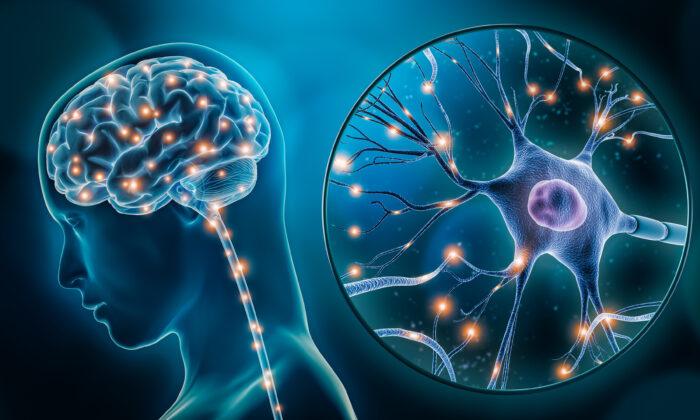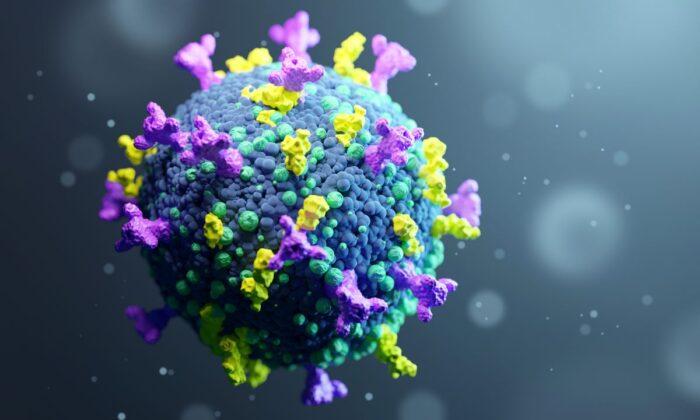When Carrie Anna McGinn woke up alone in her hotel room on Christmas morning in 2020, she thought she was experiencing the worst of her COVID symptoms. She struggled against coughing, cognitive dysfunction, pain, and postural orthostatic tachycardia syndrome.
She was isolated away from her family but expected to be back to normal in time for the New Year’s Eve celebrations. But when January came, many of her symptoms never went away, she told
Macleans Magazine.
This past January, McGinn recognized a heartbreaking anniversary—it had been over a year since she began experiencing her COVID symptoms.
Perhaps worst of all, she experiences
post-exertional malaise—a kind of fatigue that arrives after she has exerted herself, either physically or mentally. “It feels like being wrapped in a lead blanket,” she says. “It kind of feels like my cells are dying.”
What Is Long Covid?
McGinn is one of the many who have experienced what doctors are calling
post-COVID-19 condition or, more informally, long COVID.
Long COVID is characterized by new, returning, or ongoing symptoms of COVID-19 that last more than four weeks after the initial infection. Most people who contract COVID-19 get better in no more than a few weeks. But for some, the symptoms persist for months or even years.
Symptoms of long COVID vary as widely. Those suffering from the illness
report feeling fever, difficulty breathing, shortness of breath, sleep problems, changes in smell or taste, diarrhea, stomach pain, and more. Like McGinn, many also report tiredness and fatigue that gets worse after mental or physical effort, as well as cognitive dysfunction or “brain fog.”
While anyone who has been infected with COVID-19 can experience long Covid, it appears to be most likely to occur in those whose initial COVID-19 symptoms were especially severe.
Long COVID is less common in children, although some
children also experience persistent symptoms. It even affects those who are healthy and active, like
athletes.
Long COVID Seems to Be Prevalent, but Estimates Vary
Long COVID is a relatively new condition in the medical world, and so experts do not yet have standard diagnostic criteria. Earlier in the pandemic, a person had to have ongoing COVID symptoms for more than four weeks to qualify as having the disease.
More recently, post-COVID-19 condition has been defined by the
World Health Organization as a “condition that occurs in individuals with a history of probable or confirmed SARS-CoV-2 infection, usually 3 months from the onset of COVID-19, with symptoms that last for at least 2 months and cannot be explained by an alternative diagnosis.”
The inconsistency in diagnostic criteria and the wide variety of possible symptoms make it challenging to track the condition. Estimates of the prevalence of long COVID range from
7.7 million to 23 million people in the United States alone. Globally, more than 100 million people could suffer from the disease.
But estimating the prevalence of long COVID is tricky.
One of the first
studies of long COVID from Italy in 2020 found that 87 percent of hospitalized patients in their sample had at least one symptom that persisted for more than 60 days after symptom onset.
Most later studies had estimates much lower than that. For example, a study from last November estimates that only
7.3 percent of people hospitalized for COVID symptoms experience long COVID.
One
global meta-analysis was published in April 2022 and summarized the results of 41 high-quality studies that reported the prevalence of long COVID. The review estimated that, globally, post-COVID-19 conditions occurred in about 43 percent of COVID-19 cases.
Why are the estimates so varied?
It could be partly due to the result of three key factors: individual immunity, vaccines, and variants.
Vaccines May Cause Long COVID-like Symptoms
Vaccines throw a wrench in the gears of those trying to estimate the prevalence of long COVID for two reasons.The first is that vaccines appeared to produce slightly more protection against long COVID in viral breakthroughs, compared with those who were naturally infected but without vaccination.
One study of 13 million people in the United States found that patients with breakthrough infection after vaccination against the SARS-CoV-2 virus reduced the risk of experiencing long COVID
by about 15 percent.
However COVID-19 global pandemic is highly dynamic and during the study participants spread across January 1, 2021 to October 31, 2021. An obvious confounding factor is the dynamic viral mutants may cause less frequent long COVID regardless of vaccination status. As treatment strategies of the acute phase of COVID-19 continue to improve and as new variants of the virus emerge, it is likely that the epidemiology of viral breakthroughs and the risks of downstream sequelae may also change over time.
But in certain cases, vaccines may cause COVID-like symptoms.
Science magazine has reported several cases of individuals that experienced persistent COVID-like symptoms as side effects after receiving a vaccine, even when they hadn’t been exposed to COVID-19 itself.
While there aren’t yet estimates for the number of cases in which a vaccine has caused symptoms like long COVID, Science Magazine reports that a study of these individuals included at least 34 people. From social media and communities, there are many more cases who have reported brain fog, fatigue after the jabs.
Original, Delta, and Omicron Variants Show Different Rates of Long COVID
The other factor that makes estimating prevalence hard is that the virus itself has changed. And as new variants appear, they have different effects.For example, the original virus seems to have caused long COVID quite regularly. One early study that looked at cases in the United States between April 2020 and February 2021, when the original virus was prevalent, found that just under 30 percent of participants self-reported symptoms that met the criteria for long COVID.
More recent variants seem to cause it to a much lesser extent.
One of the best recent studies on the prevalence of long COVID from these later variants comes from the UK. It investigated the rates of long COVID among more than 56,000 people with self-reported symptoms that lasted longer than 28 days.
This study found that 10.8 percent of the sample of COVID cases that occurred from June to November 2021 when the Delta variant was most common led to long COVID. In contrast, only 4.5 percent of the sample of COVID cases that occurred after November 2021, when Omicron was most common, resulted in longCOVID.
In other words, Omicron may lead to long COVID only half as often as Delta did.
Similarly, the
UK Office of National Statistics reported that for double-vaccinated participants, self-reported long COVID was less common after infections compatible with the Omicron BA.1 variant than the Delta variant (4.0 percent vs 9.2 percent). It provides additional evidence that only a small proportion of people infected with an Omicron variant will experience longCOVID.
The key takeaway is that both the Delta and Omicron variants can lead to long Covid, but they seem to do so less often than the original virus.
Mechanism of Long COVID
Saurabh Mehandru and Miriam Merad from Precision Immunology Institute, Icahn School of Medicine at Mount Sinai, New York, have published a
review examining the underlying pathophysiological mechanisms of post-COVID-19 syndromes, including persistent inflammation, induced autoimmunity, and putative viral reservoirs.
S protein of SARS-CoV-2 alone can
damage mitochondrial structure and function. Mitochondria play a pivotal role in the supply of intracellular energy. The higher the metabolic activity of the cell is, the higher amount of ATP, and energy would be high.
Usually, the mitochondrial content of cells in the brain, eye retinas, muscles, and heart is relatively high. Thus, damage to mitochondria could explain the representative long-term symptoms of long COVID—fatigue, weakness, neurological and mental deficits including brain fog, as well as similar symptoms of fatigue, weakness, and neurological dysfunction that may occur due to vaccination.
A Holistic Approach to Treating Long COVID
Still, the effect can be significant. Since Omicron spreads more easily than previous variants, it has infected many more people, and as a result, may be responsible for a much larger number of long COVID cases. There are millions of people now experiencing long COVID across the world.In an article
published by the British Medical Journal, researchers make a clear case for a holistic approach to treatment. “It’s not going to be one magic bullet, one drug, or one therapy that’s going to help,” says Terence Stephenson, professor of child health at the UCL Great Ormond Street Institute of Child Health in London. “People are probably going to need a spectrum of inputs to help them.”
What does that look like, in practice?
Dr. Christian Sandrock, a professor of critical care and infectious disease medicine at the University of California,
suggests adjusting sleep, getting more rest, relieving stress, and meditating. In short, giving the body the time and space to heal itself.
There’s some evidence that this kind of approach could work. In
a large-scale genomic study, researchers found a robust activation of the immune system following an advanced meditation retreat.
The study’s authors note, “We found the response to oxidative stress, detoxification, and cell cycle regulation pathways were down-regulated after meditation. Strikingly, 220 genes directly associated with immune response, including 68 genes related to interferon signaling, were up-regulated, with no significant expression changes in the inflammatory genes.”
Critically, the meditation had its effect on exactly the immune response network that is dysregulated in patients with severe COVID symptoms.
What Else Can We Do to Fight Long Covid?
COVID will continue, but we can all continue to reduce its negative effects by working to stay healthy. That means taking care of ourselves physically, emotionally, and spiritually.
- Create healthy habits. We can avoid the lifestyle choices that negatively impact the function of immune cells, like drinking and smoking. At the same time, cultivating good habits, like sleeping adequately and eating a balanced diet, help boost the immune system.
- Develop a positive outlook. Research is increasingly clear that the mind affects the body and immune function. Remaining positive and processing negative emotions in a healthy way can help foster physical health.
- Enjoy natural experiences. Nature has an almost magical effect on our health. It can improve mental health and physical health. Forest bathing may be an especially useful activity for health, potentially reducing the risk of developing diabetes, cardiovascular disease, and premature death.
- Strive for a noble purpose. Some research even suggests that pursuing eudaimonic well-being (seeking meaning and acting nobly) can reduce the expression of pro-inflammatory genes compared to pursuing hedonic well-being (seeking pleasure). In other words, striving for a noble purpose may have profound physical consequences that can help you avoid illness.
These activities will not be a magic cure for long COVID. But taking a holistic view of health and bolstering the body’s natural ability to heal itself could be an important way for those struggling with long COVID to combat their symptoms. More generally, they can help us cultivate a healthy, happy life.
References






